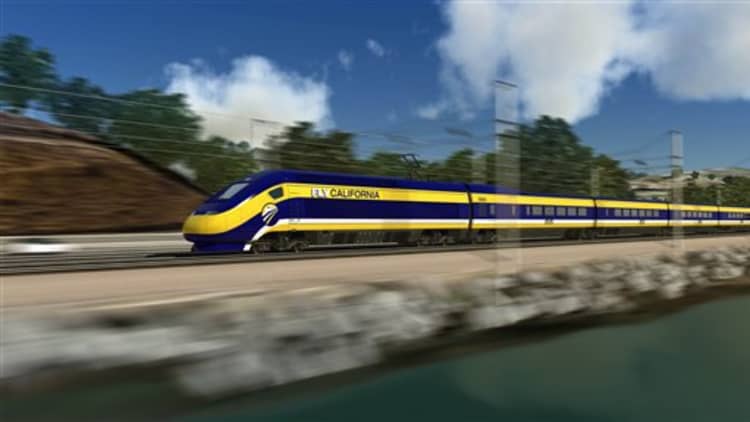LOS ANGELES — Even as President Donald Trump insists he's supportive of infrastructure projects, some say his record proves otherwise, especially when looking at high-speed rail.
On Tuesday, California sued the U.S. Department of Transportation over its decision last week to terminate a 2010 grant agreement involving nearly $1 billion in funding for the state's high-speed rail project. In its lawsuit, California charges that the U.S. government's action "was precipitated by President Trump's overt hostility to California, its challenge to his border wall initiatives, and what he called the 'green disaster' high-speed rail project."
"Trump came in when he was campaigning for president about 'how come America doesn't have rail' and actually was making some good points," said Andy Kunz, CEO of the U.S. High-Speed Rail Association, an advocacy group funded in part by rail manufacturers and some engineering firms. "But, then, when he gets into office, he becomes 'Mr. Anti-Rail' and brings in all these oil people."
Kunz said the federal government's stance on the California project "shows how out of touch the Trump administration is with the modern forms of transportation, where America wants to be, what the rest of the world is doing."
"The Trump administration has certainly not made progress on an infrastructure agenda," said Aaron Renn, a senior fellow at the Manhattan Institute, a nonpartisan think tank. "The administration put together an infrastructure plan that had some very good elements in it but didn't go anywhere in Congress."
On Wednesday, Trump abruptly ended a meeting with House Speaker Nancy Pelosi, D-Calif., and Senate Minority Leader Chuck Schumer, D-N.Y., at the White House and told reporters he won't do an infrastructure deal while Democrats are still investigating the administration. Besides California, the Trump administration also has pushed back on Northeast Corridor rail funding.
"When it comes to infrastructure, there is certainly a political element to getting anything done in states like California and New York that want to declare themselves the resistance," said Renn, citing everything from lawsuits to sanctuary state policies. "You have to expect that the Trump administration is going to do the same exact thing."
In California, construction is underway on the first leg of the California high-speed rail project, a 119-mile section connecting the Central Valley cities of Merced and Bakersfield. More than $5 billion has already been spent on the project, including $2.5 billion in funds from the federal government, according to the California High-Speed Rail Authority.
"The federal government is using transportation funds which California taxpayers paid for, and so we think that getting some of our transportation dollars back here is an appropriate thing," said Democratic Sen. Jim Beall, who represents the Silicon Valley area and is chair of the Senate Committee on Transportation.
Beall called the California project the "nation's most advanced high-speed rail project," adding that others around the country are "more of a planning-stage kind of level." He said the Trump administration's move to pull funding for the project shows "a lack of will to fund transportation projects at a national level."
The DOT's Federal Railroad Administration said last week that it is continuing to explore "all options" concerning the federal funds already awarded to the state's high-speed rail agency.

Future funding for the project is expected to come partly from bonds and cap-and-trade program money, but there are critics in the state legislature who would prefer to see the project abandoned. California's Democratic Gov. Gavin Newsom also has said he wants private funding to help in the rail system.
"The best course of action is to pull the funds from the project like the federal government is doing and put them into infrastructure projects for water storage that is desperately needed for California," said California Senate Republican Leader Shannon Grove of Bakersfield. "The Central Valley isn't really excited about this project. They believe it's a train to nowhere."
The California governor reached a deal with the administration Wednesday that will mean the feds won't repurpose rail funds until the pending lawsuit is resolved, according to the Los Angeles Times. The governor's office did not immediately respond to CNBC's request for comment on the deal. Newsom and Trump have sparred over many other issues, including health care, the environment, immigration, and wildfire-related funding.
In February, Newsom at his first state of the state address announced a reeling-in of the high-speed rail project, saying the current plan "would cost too much and take too long." He added, "There simply isn't a path to get from Sacramento to San Diego, let alone from San Francisco to LA."
Kunz said Newsom himself is partly to blame for the rail controversy with Trump "by making that muddled announcement."
California's bullet train effort originally was touted as linking San Francisco to Los Angeles but has faced numerous delays and cost overruns. In 2008, California voters approved a ballot measure authorizing nearly $10 billion in bond money for the first phase of a roughly 800-mile high-speed rail network that was targeted for completion in 2020.
"The California high-speed rail plan makes no sense," said Renn. "It was originally a $10 billion bond, and now who knows what it's going to be."
"A lot of people like to talk about high-speed rail in other countries, but in other countries, they actually build reasonably priced functional lines," Renn said. "That's something we haven't been able to do."



